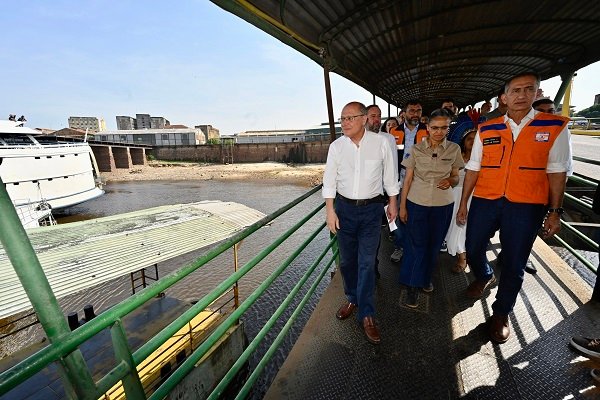Extreme climatic phenomena have been causing disasters in the North and South of Brazil, with deaths, displacement of families, destruction of various properties, interruption of economic activities, and obstruction of highways, streets, airports, waterways and other logistical routes. In the North, an extreme drought caused by El Niño led to the reduction of the rivers’ level to a history low. In the South, the opposite scenario was observed, with heavy rains leading to floodings, landslides and more.
Drought in the North Region
For climate experts, the recent drought that has been hitting the Amazon could cause the worst situation in the region’s entire history, extending the dry period to the year 2024. The forecast was disclosed by the National Center for Monitoring and Alerts of Natural Disasters (Cemaden).
The Madeira, an important river for transporting passengers and cargo that extends itself from Porto Velho (RO) to Itacoatiara (AM), was one of the most affected. The low levels in this river caused the interruption of transports in general, and even hampered energy production. But this was not the only one, various major rivers have reached very low levels, such as: Solimões, Negro, Juruá, Purus rivers also became deserts in some parts, leading to food and water shortage in some communities and difficulties for people to move around the area.
The Jirau and Santo Antônio hydroelectric plants were built on the waters of the Madeira river. Together, the two plants represent 6.7% of the installed power of the interconnected electrical system. On 2 October, the National Electric System Operator (ONS) announced the suspension of the operation of the Santo Antônio hydroelectric plant due to the drought, as the plant does not have a reservoir. The Electrical Sector Monitoring Committee (CMSE) recognized that the crisis in the Madeira River basin could compromise service to the states of Acre and Rondônia. Besides that, the river is also a source of biodiversity, food an work, thus these three fronts in which the regional society can be negatively affected.
Heavy Rains in the South
Heavy rains have hit Santa Catarina for more than a week, causing at least two deaths and incidents in 93 cities in the state. Due to the high volume of rain, Governor Jorginho Mello ordered the closure of the Ituporanga and José Boiteux dams on Saturday. However, this also led to a social conflict. An indigenous community that has territory around the dams protested and attempted to prevent the closure of the dams in order to avoid the flooding of their lands and the destruction of buildings that belong to their community. The police intervened and there were clashes.
At least ten highways across the state were partially or completely closed due to the collapse of other dams and erosion of lanes.
A few weeks earlier, in the beginning of September, Rio Grande do Sul experienced a similar scenario after the passage of an extratropical cyclone. At least 49 people died, several other went missing, more than 900 people were injured and more than 100 cities recorded damage and disruptions with rain caused by the passage of the cyclone.
Now, in the beginning of October, another climate crisis has emerged in Rio Grande do Sul with a great increase in the level of Uruguay river. The State Civil Defense sent warnings to Barra do Guarita, Iraí and Porto Mauá, cities that are already being affected, at the moment. Nevertheless, other locations along the Uruguay River, in the regions of Upper, Middle and Lower Uruguay can be hit by the floodings.
El Niño: Draughts and Heavy Rains
Experts explain that the El Niño phenomenon causes, at the same time, a significant reduction in rainfall in the North and in the Northeast, and an increase in rainfall in the South region. Thus, so far it is within normal parameters, although it is possibly evolving into what is called “Super El Niño”, already observed between 2015 and 2016.
Even before the period that El Niño typically manifests itself, the country is already witnessing extreme events connected to this phenomenon. The effects are the potentiation of rains and droughts, both become very intense.
Researchers of climate connect this effect with the accumulation of greenhouse gases in the atmosphere, the “blanket” that protects the planet — which is the atmosphere — becomes denser. Thus, the energy we receive from the sun is retained in a greater way, a factor that gives more energy to the climate system and makes events happen with a much greater intensity.
Lack of Preparation by the State
Furthermore, experts assess that the consequences being observed show a lack of preparation and anticipation on the part of state, municipal and federal governments, as this forecast was already available a few months ago. The government sphere could, therefore, have prepared itself by providing subsidies or setting up a support structure so that the population would not suffer so much.
In the case of the Amazon, for example, the lack of highways directly affects the lives of individuals, who depend on rivers to navigate through the region — a characteristic that prevents them from receiving water, food, medicine, etc. Thus, the phenomenon has economic and social implications
Fires in the North
In addition to the droughts and heavy rains, the climate in the North region has been affected by a series of criminal fires, particularly around the capital of Amazonas state. Manaus has been suffering with hundreds of fires, which, on Thursday (12/10), for the second consecutive day, left the city’s landscape covered by smoke. The pollution affected the air quality, which reached levels that are very harmful to health.
Data from the National Institute for Space Research (Inpe) points to a record number of hot spots in Amazonas. There were 2,684 registrations in the first ten days of October in the state alone, compared to 1,503 in the entire month last year.
The increase in forest fires led the government of Wilson Lima (União Brasil) to declare, in September, an environmental emergency. The Federal Police (PF) investigates the incidents.




